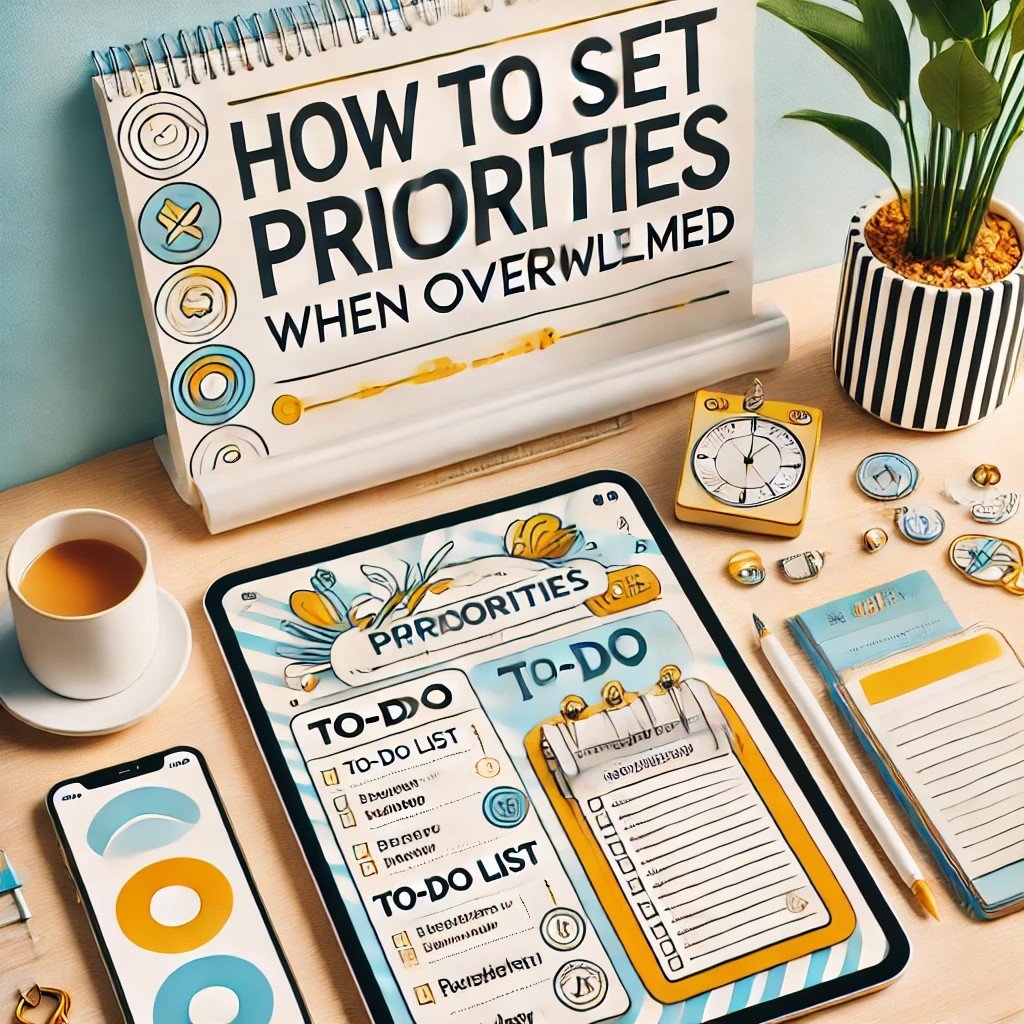
Do you ever wonder how to set priorities when overwhelmed? You’re not the only one. Many people face the same problem. When your to-do list feels too long, it’s hard to know where to start. But don’t worry, there are simple ways to take control.
First, take a deep breath and write everything down. Getting tasks out of your head makes things feel lighter. Then, pick the three most important things to focus on today. Start with small, easy steps to build momentum. Let go of things that can wait.
You don’t have to do it all at once. The goal is to do what matters most, not everything at once. With time and practice, setting priorities will feel easier and more natural. This guide will help you learn how to stay calm, clear, and focused, no matter how busy life gets.
How To Set Priorities When Overwhelmed?
Take a Step Back and Breathe
How To Set Priorities When Overwhelmed? When you feel overwhelmed, it’s normal for your brain to go into fight-or-flight mode. This makes it hard to think clearly or make good choices. The first thing you should do is stop and take a deep breath. Try this: breathe in for 4 seconds, hold your breath for 4 seconds, then breathe out for 4 seconds. Do this three times. It will help calm your mind.
You can also close your eyes for a moment and notice how you feel without judging yourself. Just be kind to yourself. Next, try a brain dump. Take a pen and paper and write down everything that’s on your mind. Big or small, just get it out of your head. This helps make things feel less heavy and more clear.
A short walk or a 5-minute mindfulness break can also help. These small actions help you feel more calm, more focused, and ready to plan your next step. Remember, you don’t have to fix everything at once. Just start with one calm breath.
Identify Your Non-Negotiables
When your to-do list feels too long, it’s important to remember that not all tasks are equal. Some things need to be done right away, while others can wait. When you think, how to set priorities when overwhelmed? To set clear priorities, ask yourself a few simple questions: What must get done today? What will cause problems if it’s not finished? What helps me reach my bigger goals?
Once you answer these, choose 3 to 5 tasks that are non-negotiable. These are the things you will focus on first. Don’t worry about doing everything. Just focus on what matters most today.
To make things even easier, try making two short lists: one called “Must-Do” and the other called “Can-Wait.” This way, you can clearly see what’s urgent and what’s not.
Doing this helps reduce stress and gives you a clear plan for the day. It also helps you feel more in control and confident. When you focus on the most important tasks, you make real progress, even on the busiest days.
Use the Eisenhower Matrix
When you feel overwhelmed, it’s hard to know what to do first. A simple and helpful way to set priorities is by using the Eisenhower Matrix. This tool helps you sort your tasks into four groups.
- Urgent & Important – Do these tasks first. They need your attention right away, like deadlines or emergencies.
- Important but Not Urgent – These tasks help your long-term goals, like learning a new skill or making a plan.
- Urgent but Not Important – These are tasks you can give to someone else, like replying to some emails.
- Not Urgent & Not Important – These are distractions, like scrolling on your phone. You can skip or remove these.
To make this fun and easy, try writing your tasks on different color sticky notes. Place them into the right group. This helps you see what needs action now and what can wait.
Using the Eisenhower Matrix helps you stay focused and calm. You’ll stop wasting time on unimportant things and spend more time on what truly matters.
Follow the Rule of Three
When your to-do list feels too long, it can be hard to get started. That’s why the Rule of Three is so helpful. Instead of doing everything, just choose three important tasks for the day.
Pick one task that helps you move a big project forward. Choose another that keeps your daily work running smoothly. Then add one task that helps you grow; this could be reading, learning, or self-care.
This way, you’re making real progress without feeling stressed or burnt out. You’re focusing your time and energy where it matters most.
To stay on track, write your three tasks on a sticky note and place it on your desk. Keep it simple. Don’t use too many sticky notes; too many can make your space feel messy and overwhelming. The Rule of Three makes each day feel more doable. You’ll feel proud of your progress and more in control. Less stress, more focus. One day at a time.
Batch Similar Tasks
Switching between too many tasks can make you feel tired and stressed. Your brain needs extra energy every time you switch between different types of work. A smart way to save your energy is to group similar tasks together. This is called task batching.
For example, answer all emails and make phone calls at one set time during the day. Don’t keep checking them again and again. This helps you stay focused.
If you’re doing creative work like writing or designing, block off time just for that. Turn off distractions and give it your full attention. When running errands, plan ahead so you can do many things in one trip. This saves both time and energy.
Making a simple daily or weekly plan to group similar tasks will make your days feel easier. You won’t have to constantly switch your focus, and that means less stress.
Task batching is a great way to stay calm and get more done when life feels overwhelming. Try it, and you’ll notice how much smoother your day goes.
Set Time Limits and Boundaries
One great method is the Pomodoro Technique. Work for 25 minutes, then take a 5-minute break. This keeps your mind fresh and your focus sharp.
To avoid losing time, turn off notifications on your phone or computer. Find a quiet space where you won’t be distracted. A calm space helps you think better and work faster.
When you feel overwhelmed, it’s not just about picking the right tasks; it’s also about managing your time wisely. Good time management helps you feel more in control. You can also use simple apps like Todoist or Trello to keep track of your tasks. These tools let you set reminders and deadlines, so nothing gets forgotten.
Using these tips will help you finish your work with less stress and more success. Just start small, and you’ll feel the difference.
Learn to Say No
Your time is important, and it’s okay to protect it. When you’re already busy, saying “no” is not rude; it’s smart. If someone asks for your time and it doesn’t match your main goals, you can kindly say no.
Here are some simple ways to do that:
- “Thanks for asking, but I’m fully booked right now.”
- “That sounds nice, but I need to focus on my current work.”
- “I can’t help at the moment, but maybe we can talk about it later.”
These are polite, honest ways to protect your time and energy. You don’t have to do everything for everyone. Your priorities matter.
Setting boundaries is a big part of managing your time when you feel overwhelmed. If you say yes to everything, you’ll end up feeling tired and stressed.
Start by saying “no” in small moments. With practice, it gets easier to speak up when bigger things come along. Remember, every time you say “no” to something that doesn’t fit your goals, you’re saying “yes” to what truly matters to you.
End Your Day with a Plan for Tomorrow
Before you end your workday, take just five minutes to slow down and review. Look at what you finished today. Celebrate the progress, even if it was small. Then, think about what still needs to be done and if anything needs to be moved or changed.
Next, write down your top three tasks for tomorrow. This way, when you start your day, you already know what to focus on. It saves time, lowers stress, and helps you feel more in control.
This small habit makes a big difference, especially when you’re feeling overwhelmed. Planning ahead gives your day structure and keeps your goals clear.
Using a planner or journal can help. You can write what you got done, what’s still pending, and how you’re feeling. Over time, you’ll start to notice patterns—like when you’re most focused or what tasks take longer than expected.
This end-of-day habit helps you rest with peace of mind and wake up ready. It’s a simple step, but it brings big calm. Try it tonight, and feel the difference tomorrow.
Take a Breath and Get Started
Feeling overwhelmed is normal. Everyone goes through it at times. But the good news is you can take control with simple steps.
Start by choosing what’s most important. You don’t have to do everything at once. Pick just one task that matters most and begin there. Small steps add up.
Set clear boundaries. It’s okay to say “no” when you’re already busy. This helps you protect your time and energy.
Focus on what truly matters, not on being perfect. Progress is better than perfection. Even small actions, done regularly, bring big changes over time.
You can also make a short list of daily tasks. This helps you stay calm and focused. A quick five-minute plan at the end of each day can guide your next steps.
Remember, you are not alone in feeling overwhelmed. But you don’t have to stay stuck. One small action today can lead to a better tomorrow. Take a breath, start small, and keep going. You’ve got this.
Final Thoughts
If you’re feeling overwhelmed or stuck, when you wonder how to set priorities when overwhelmed, know that you don’t have to navigate it alone. Together, we can create tailored strategies to simplify your life, reduce stress, and help you focus on what truly matters.
Whether it’s finding clarity through mindfulness or boosting productivity with effective systems, I’m here to guide you every step of the way. Let’s work together to transform your challenges into opportunities for growth. Contact me today to take the first step toward a more balanced, intentional, and fulfilling life!

Curious about how mindful your space is? Take our quiz here.
